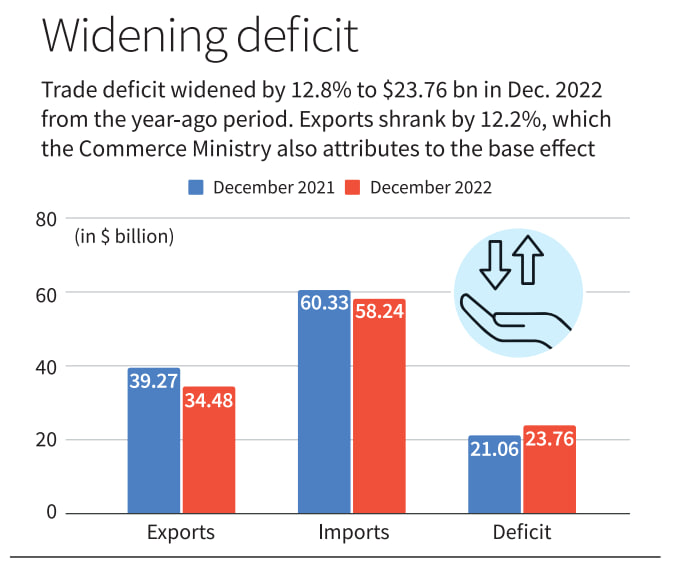Description

Copyright infringement not intended
About:
- India’s merchandise trade deficit increased from below $24 billion in November to $24.24 billion in December.
- As per Global Composite Purchasing Managers’ Index report (January 2023), new export orders have been declining for the 10th consecutive month in December.
- 19 of 30 major exporting sectors shrank in December, including;
- Cotton yarn and handlooms (-40.4%).
- Handicrafts (-36.9%)
- Petroleum products (-26.9%)
- Plastic and linoleum (-26.23%)
- Gems and jewellery (-15.2%)
- Engineering goods exports dropped nearly 12%.
- Exports from the readymade garments (RMG) sectors grew by a mere 1.02% in December.
.jpeg)
Trade deficit:
- A trade deficit is an amount by which the cost of a country's imports exceeds its exports.
- It's one way of measuring international trade, and it's also called a negative balance of trade.
- A trade deficit can be calculated by subtracting the total value of a country's exports from the total value of its imports.
What Causes a Trade Deficit?
- It can be hard to pinpoint the exact cause of a trade deficit. Typically, multiple factors are at play. Here are some of the leading causes of an increase in a country's trade deficit.
- Economic growth: A large trade deficit can indicate economic growth. When the economy of a country grows and strengthens, consumers have more wealth to purchase goods from overseas, which will increase the trade deficit. A strong economy also attracts foreign investors, further enlarging the trade deficit.
- Increased government spending: An increase in government spending can mean a country's savings diminish, increasing the trade deficit.
- Changes in the exchange rate: A change in the strength of a country's currency can impact the trade deficit. When a country's currency weakens relative to other nations, trade between other countries becomes more costly. If a country’s currency is strong, it may want to import more goods or services.
- Limits of production: Certain goods simply cannot be produced domestically, or are much cheaper to produce abroad due to climate, natural resources, or other reasons. For example, a small island nation may rely on imports of agricultural products from the mainland.
- Removal of barriers to trade, such as tariffs: Trade policy can affect the trade deficit, but unless the country was previously closed to trade, trade policy mostly serves to shift the trade deficit toward another trading partner, rather than creating or increasing the overall trade deficit.

Potential Effects of a Trade Deficit:
- Lower prices: A country may have a trade deficit because it is cheaper to purchase goods internationally than to produce them at home. This means that prices of consumer goods and services may decrease.
- Weakening currency: A trade deficit has the potential to weaken a country’s currency.
- Deflation: A country that has a trade deficit is sending a portion of its currency overseas. This can cause deflation, a state in which reduced demand leads to lower prices.
- Changes in employment: If a country imports more than it exports, unemployment may increase. For example, if a country shifts from manufacturing cars to importing cars from international car manufacturers, the job market for car manufacturing will be negatively impacted. Some economists argue that the reduced prices caused by a trade deficit can make up for these losses, by allowing resources to be allocated to new jobs, while others suggest that workers displaced by shifts in trade are unlikely to benefit from jobs created in other fields.
- Decrease in GDP: Trade deficit is one factor used to calculate a country’s Gross Domestic Product (GDP), a measure of the size of the economy. If the trade deficit increases, the GDP decreases.

https://epaper.thehindu.com/Home/ShareArticle?OrgId=GR2AOQNJG.1&imageview=0
















